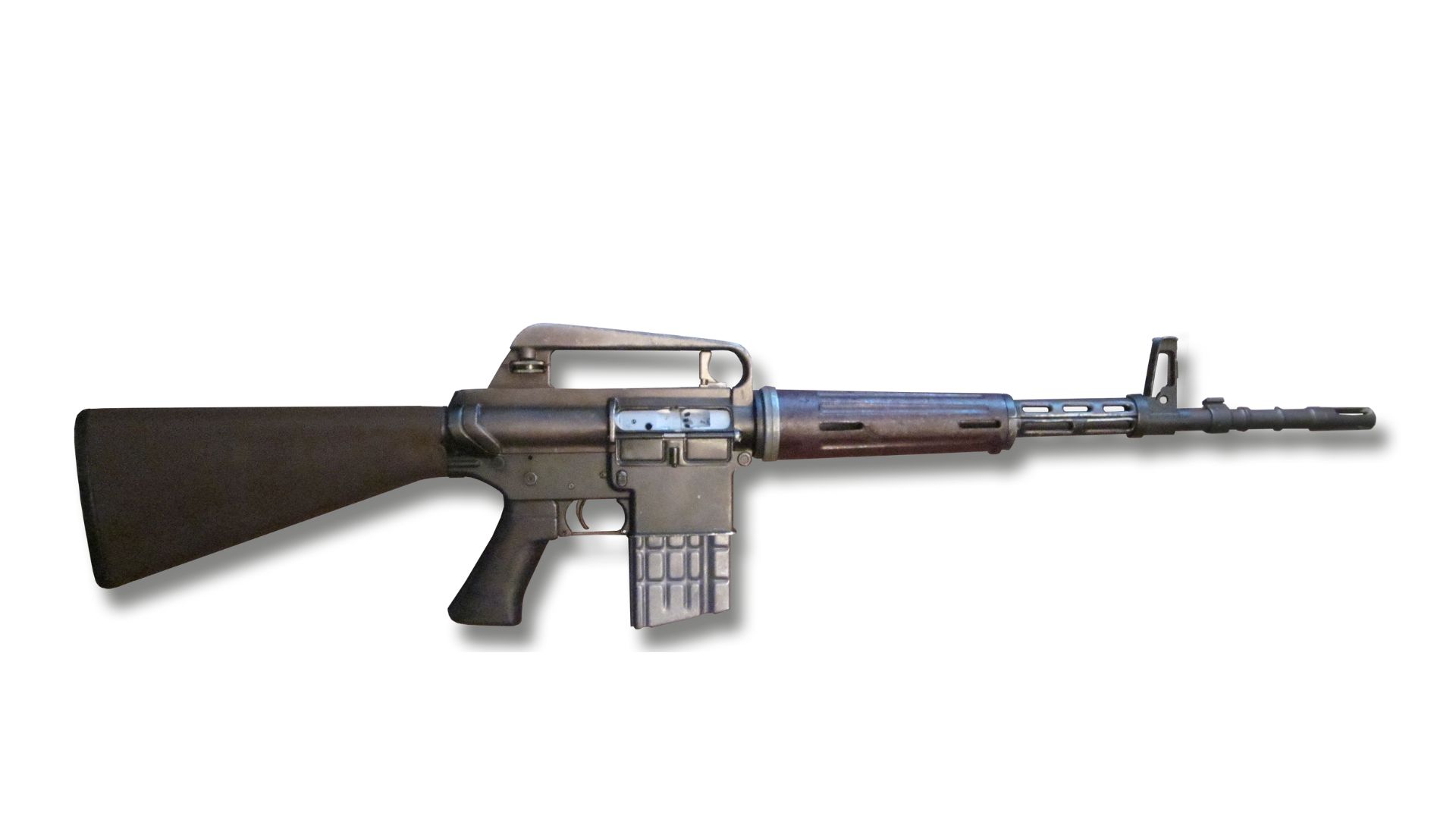The AR-10, designed by Eugene Stoner in the mid-1950s, revolutionized modern firearms with its lightweight materials and innovative gas system.
Although the AR-10 was never adopted by the U.S. military, its influence on subsequent rifle designs is undeniable. This article explores the AR-10’s history, development, and lasting impact on military firearms. From its initial rejection to its role in shaping the iconic M16, discover the story behind one of the most pivotal rifles in modern history.
The Need for Modernization
The M1 Garand defined American infantry power during World War II. Gen. George S. Patton, Jr., praised it as “the greatest battle implement ever devised.”
Reliable and effective, it played a crucial role in the Allies’ victory. The M1 Garand, with its semi-automatic operation, provided a significant advantage over the bolt-action rifles used by many other forces. It allowed soldiers to fire eight rounds in rapid succession without having to manually cycle the action.
By the late 1940s and early 1950s, advancements in firearm technology were accelerating. The U.S. military needed a new service rifle that could meet modern demands. The days of the M1 were numbered.

Combat experience during World War II had shown the benefits of higher rates of fire and the importance of automatic capability. The Garand, though effective, was limited by its eight-round en-bloc clip and semi-automatic action.
Recognizing the need for faster firing rates, the ability for fully automatic fire, and the use of box magazines, the U.S. military began searching for the next-generation rifle.
The establishment of NATO after World War II influenced this search. NATO aimed to standardize the equipment used by member forces to ensure interoperability. To this end, a “Rifle Steering Committee” was established to develop a standardized rifle for NATO nations. This committee sought to create a rifle that could be used universally by the armed forces of all member countries.
The Development of the AR-10
Eugene Stoner, working for ArmaLite, developed the AR-10 in the mid-1950s. This new design with forged alloy, fiberglass and aluminum components departed from the traditional wood stock of the M1 Garand.
The AR-10 featured a straight-line design with elevated iron sights, a recoil compensator, and a patented gas system. This system used gas from a fired cartridge to cycle the action, making it more efficient and reliable. Stoner’s gas system bled gas from the barrel through a small port, then traveled back to the receiver to cycle the bolt.
SOFREP’s Guy McCardle, a small arms expert and 16-year Army veteran, had the following to say about the AR-10:
“The AR-10, although not adopted for widespread use in the US military was clearly ahead of its time with its adjustable gas system and lightweight components. Had it not been for the catastrophic failure of its aluminum/steel composite barrel during government torture testing, it would have likely gone into widespread production instead of the M14. As it was, technology finally caught up with the concepts behind the AR-10, which led to the direct development of the AR-15 and M16.”
Key Features and Innovations
The AR-10 was chambered for the 7.62×51 mm NATO cartridge, similar to the .308 Winchester. Its aluminum alloy receiver and fiberglass components made it lighter than other rifles of its era.
The innovative gas system set it apart from competitors. The design also included a recoil compensator to reduce muzzle climb during automatic fire. These features combined to make the AR-10 a lightweight, reliable, and effective battle rifle.
Gas System
The AR-10’s gas system was revolutionary. Unlike traditional gas-operated rifles that used a piston to drive the bolt carrier, Stoner’s design redirected gas directly into the bolt carrier group.
This system reduced the number of moving parts and simplified maintenance. When a round was fired, gas was siphoned through a port in the barrel into a gas block at the front sight base. From there, it traveled back through a gas tube into a key on the bolt carrier. The gas pushed the bolt carrier rearward, unlocking the bolt and extracting the spent cartridge.
Materials and Weight
The use of lightweight materials was another significant innovation.
The AR-10’s receiver was made from an aluminum alloy, and the stock, pistol grip, and handguards were constructed from reinforced fiberglass. These materials made the AR-10 about a pound lighter than other contemporary infantry rifles. The lighter weight made it easier for soldiers to carry and maneuver, especially in combat situations.
The Testing Setback
Despite its innovative design, the AR-10 faced significant challenges during testing. One major issue was the barrel. ArmaLite’s president, George Sullivan, insisted on using a composite barrel made of aluminum and steel despite Stoner’s objections.
This barrel burst during a torture test conducted by Springfield Armory in 1957. The failure was catastrophic and led Springfield Armory to reject the AR-10 despite a quick fix with an all-steel barrel. The U.S. Army viewed the AR-10 as too experimental and opted for the more conventional T44, which became the M14.
Despite its rejection by the U.S. Army, the AR-10 found some success abroad. ArmaLite licensed the design to various nations and manufacturers, including the Dutch group Artillerie Inrichtingen.
The rifle saw service in countries like Sudan, Portugal, Guatemala, Burma, Italy, and Cuba. These nations appreciated the AR-10’s lightweight design, stopping power and advanced features, even if the U.S. military did not adopt it.
The AR-10’s Influence
In 1957, ArmaLite sought to develop a new service rifle for the U.S. Continental Army Command. The goal was a .22-caliber select-fire rifle weighing under six pounds and accurate to 500 yards.

Stoner, along with Jim Sullivan and Bob Fremont, revisited the AR-10’s design and created the AR-15, chambered for the .223 Remington cartridge. Introduced in 1958, the AR-15 gained significant interest and eventually led to the creation of the M16, the U.S. military’s standard service rifle.
Global Usage
The AR-10 never gained widespread military adoption but influenced future rifle designs. ArmaLite sold the AR-10 and AR-15 designs to Colt in 1959. Stoner left ArmaLite in 1961, and the company struggled until Mark Westrom revived the ArmaLite brand in 1995. He introduced the AR-10B, based on Colt’s AR-15A2 and designed to use the .308 round.
Today, several manufacturers produce AR-10 style rifles, including ArmaLite, DPMS, Palmetto State Armory, Ruger, Smith & Wesson, and Windham Weaponry.
These rifles come in various patterns, but they continue the legacy of the original AR-10, serving military forces, competitive shooters, hunters, and recreational gun owners worldwide. The AR-10 platform has evolved to meet modern standards, with improvements in materials, manufacturing processes, and accessories.
Eugene Stoner’s genius gave us both the AR-15 and the AR-10. While the AR-15 became the iconic service rifle, the AR-10 remains a testament to innovative design and engineering. Nearly 70 years later, the AR-10’s influence persists, proving that a well-designed battle rifle can stand the test of time.
The M14’s Selection and Impact
The Conventional Choice
The M14 was selected as the new standard service rifle for the U.S. military, replacing the M1 Garand.

The decision was influenced by the need for a rifle that could be quickly adopted and fielded. The M14, being essentially an improved M1 Garand with a detachable box magazine and selective fire capability, fit the bill. It provided a familiar platform for soldiers transitioning from the Garand.
Field Performance
The M14 saw extensive use during the early years of the Vietnam War. Its powerful 7.62×51 mm NATO cartridge offered excellent range and stopping power. However, the M14 was heavy and difficult to control in fully automatic fire. The rifle’s length and weight made it cumbersome in the dense jungles of Vietnam. These issues highlighted the need for a lighter, more controllable rifle.
The Rise of the M16
The AR-15, developed by Stoner and refined into the M16 by Colt, addressed many of the M14’s shortcomings.

The M16’s smaller, high-velocity 5.56×45 mm NATO cartridge allowed soldiers to carry more ammunition.
Its lightweight design improved maneuverability, and the rifle’s controllability in fully automatic fire was significantly better. By the mid-1960s, the M16 had begun to replace the M14 in U.S. service.
The AR-10’s Influence on the M16
The M16’s design drew heavily from the AR-10. Stoner’s gas system, lightweight materials, and straight-line design were all incorporated into the M16. The success of the M16 in Vietnam and its continued use in various conflicts around the world can be traced back to the innovations introduced with the AR-10.
Continued Evolution
The M16 and its carbine variant, the M4, have seen numerous updates and improvements over the years. Enhanced materials, better manufacturing processes, and new accessories have kept these rifles at the forefront of military technology. The basic principles introduced with the AR-10 remain integral to these designs, demonstrating the lasting impact of Stoner’s work.
The AR-10’s Legacy Today
Modern Manufacturing
Today’s AR-10-style rifles are produced by several manufacturers, each bringing their own innovations to the platform. These rifles are chambered in .308 Winchester or 7.62×51 mm NATO, offering versatility for various applications. Modern AR-10s benefit from advancements in materials and manufacturing, resulting in rifles that are more reliable, accurate, and durable than ever before.
Versatility and Customization
One of the key strengths of the AR-10 platform is its versatility.
Users can customize their rifles with a wide range of accessories, including optics, grips, stocks, and rail systems. This adaptability makes the AR-10 suitable for military, law enforcement, competitive shooting, hunting, and recreational use.
Global Influence
The influence of the AR-10 extends beyond the United States. Various countries have adopted AR-10 style rifles for military and law enforcement use. The design principles pioneered by Stoner have also influenced the development of other modern battle rifles around the world.
Final Verdict
The AR-10 may not have been adopted as the standard service rifle by the U.S. military, but its impact on modern firearms cannot be overstated.
Eugene Stoner’s innovative design laid the groundwork for the AR-15 and M16, which have become iconic weapons in their own right. The AR-10’s legacy lives on through modern variants and its lasting influence on rifle design. Nearly 70 years after its creation, the AR-10 remains a testament to the power of innovation and engineering excellence in the world of firearms.
__
Disclaimer: SOFREP utilizes AI for image generation and article research. Occasionally, it’s like handing a chimpanzee the keys to your liquor cabinet. It’s not always perfect and if a mistake is made, we own up to it full stop. In a world where information comes at us in tidal waves, it is an important tool that helps us sift through the brass for live rounds.










COMMENTS
You must become a subscriber or login to view or post comments on this article.